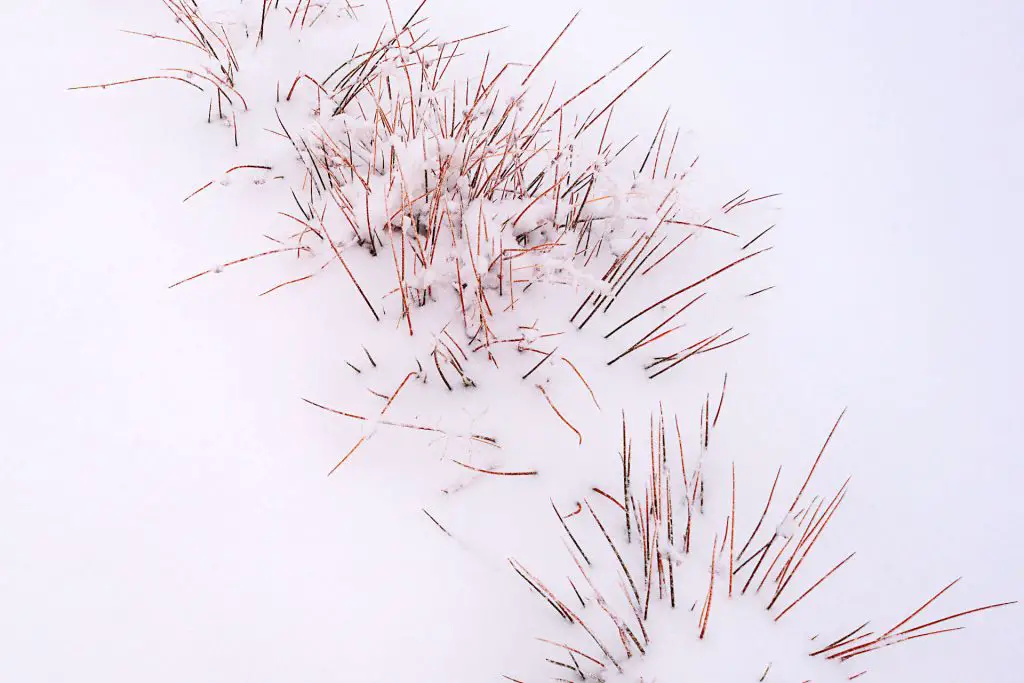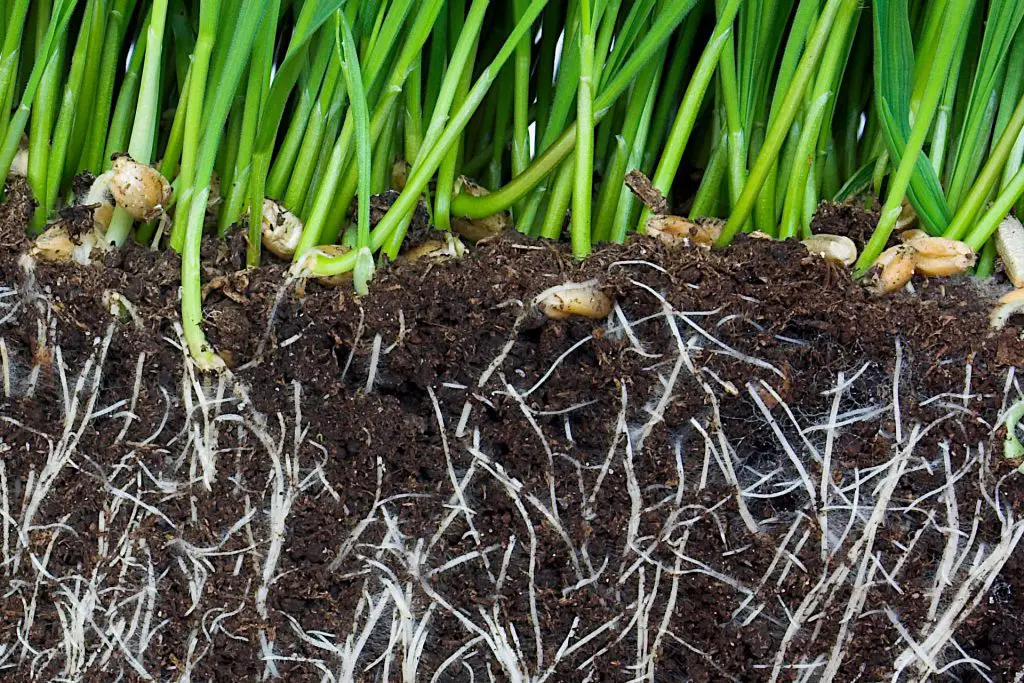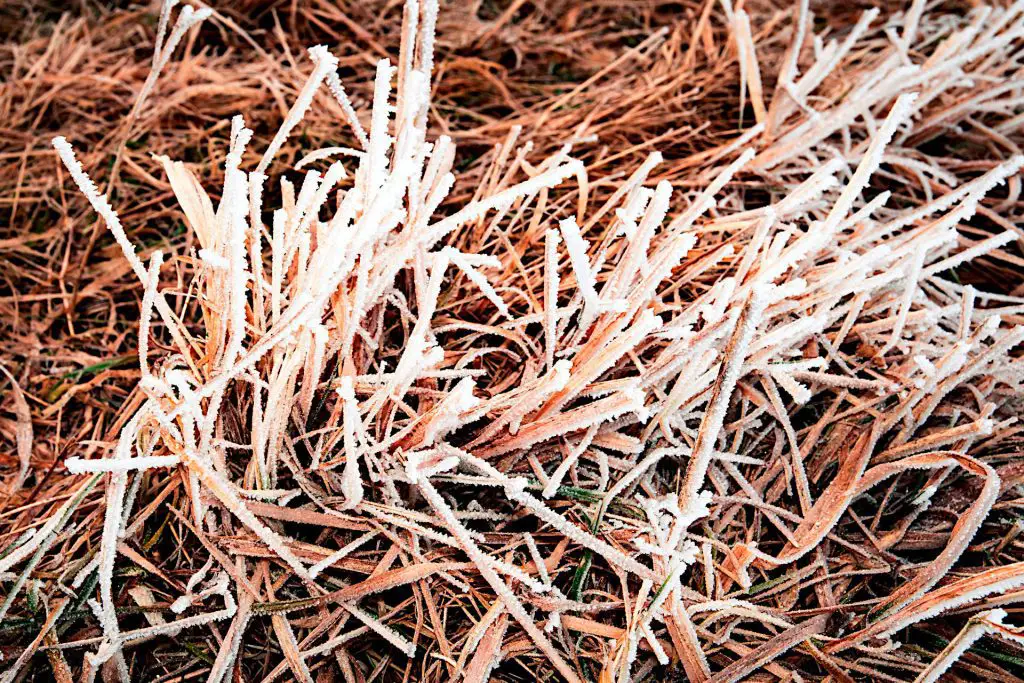How Much Does a Frost Affect Grass Seed Germination?
The impact of frost on grass seed germination can be significant, depending on the type of grass, the severity of the frost, and the length of time the seed is exposed to cold temperatures.
For most grasses, a light frost will not have a significant impact on germination rates. However, a severe frost can damage the tender grass seedlings, and may even kill them.
The length of time that the grass seed is exposed to cold temperatures is also a factor. If the seed is exposed to the cold for a prolonged period of time, it can be killed.
Some Grass Types Are More Resilient

Generally speaking, warm-season grasses such as Bermuda grass are more susceptible to freezing weather than cool-season grasses.[1]
There are some grasses that are more tolerant to frost than others. These grasses include:
- Poa pratensis ( Kentucky bluegrass)[2]
- Festuca rubra (red fescue)[3]
- Lolium perenne (perennial ryegrass)[3]
When it comes to grass seed germination, one of the biggest concerns is frost. Many people are unsure of how much frost affects grass seed germination and whether or not they should be worried about it.
The truth is, frost can have a significant impact on grass seed germination. In fact, in some circumstances, usually with pre-soaked seeds, frost can actually kill the seeds. This is because when grass seeds are exposed to frost, the water inside the seed expands and ruptures the seed coat. This damage can prevent the seed from germinating.
How to Germinate Grass Seed in Cold Weather
The best way to find out is to talk to your local Cooperative Extension office. They can help you determine which type of grass seed is best for your area and what the best time to plant is. You can also check the frost dates for your area. These are the dates when the average air temperature is below freezing. You can find these dates online or in your local newspaper. Keep in mind that these are only averages. So, if you live in an area that is prone to early or late frosts, you may want to adjust your planting schedule accordingly.
Germination Rate
A variety of factors, including the kind of grass, the season, the climate, temperature, and the degree of moisture in the soil influence how quickly grass seed will germinate.
Watering
It is impossible to overstate how crucial it is to water consistently after planting the grass seeds. It becomes difficult for proper germination of the seeds if they do not have access to adequate moisture for at least three to four weeks after they have been planted.
If you are planting warm-season grasses these grass varieties tend to have a greater requirement for water, thus this is something that should be accounted for in your watering strategy.
Timing
Don’t forget that you can always try to plant your grass seed a little earlier or later than the average frost date. This can help you avoid the worst of the frost damage.
If you are concerned about the impact of frost on your grass seed germination, you can take some steps to protect the seed:
- Plant the seed in late fall or early winter, before the first frost is expected.
- Apply a layer of mulch, such as straw, around the seed bed. This will help insulate the soil and protect the seedlings from the cold.
- If a frost is expected, water the seed bed thoroughly before the frost arrives. This will help prevent the seedlings from being damaged by the frost.
Why Does Frost Cause Damage?

Frost can cause damage to grass seed germination because it creates an unfavorable environment for the seeds to grow. When the temperature drops below freezing, the water in the soil freezes and expands. This can cause the soil to heave, or push up, damaging the grass plants and their roots. The damage is most severe when the soil is wet and the frost is deep.
Frost can damage the grass plant in several ways.
- Firstly, frost can damage the cells of the seed, which can prevent the seed from germinating.[4]
- Secondly, by rupturing the cell walls of the plant. This can happen when the water in the cells freezes and expands, causing the cell walls to rupture.
- Thirdly, frost can cause the soil to freeze, it can form a hard crust on the surface which can also prevent the seed from germinating.
- Fourth, by damaging the plant’s roots. The roots are very sensitive to cold temperatures and can be easily damaged by frost.
- Finally, frost can damage grass is by killing the young grass seedlings. The young plants are very sensitive to the cold and can be killed by exposure to frost and heavy frost can prevent water and nutrients from getting to the root system.
How Does Frost Effect the Germination Process
As we have seen frost can have a negative effect on grass seed germination. In the northern hemisphere, frost typically reduces grass seed germination by 50%.
At What Temperature is It Too Cold for Grass Seed to Grow?
When it comes to grass seeds, cold weather has a direct impact on the germination rate. In general, grass seed germination rates are affected by the temperature between the time the seed is sown and the point that it has become established. This is usually a 12-week period in ideal growing conditions. But, the colder the temperature, the greater the impact on the germination rate.
Dormant Seeding
Dormant seeding is the practice of planting grass seeds when the temperature drops below that at which the seeds will germinate. The reasoning is that winter soil is often less hard and dry, which facilitates planting and enhances seed-to-soil contact. The seeds will remain dormant in the ground until the sunlight increases, the temperature rises, and showers begin in the spring.
Dormant grasses are more susceptible to frost and disease. This is because the grasses are not actively growing and their immunity is lowered. This can lead to the dormant seeds being more difficult to revive in the spring. If you are planning on overseeding your lawn in the fall, it is important to make sure that the seed you are using is designed for cold-season grasses.
Cool-Season Grasses
If you live in a cold climate, cold-season grass types go dormant when the soil temperature falls below around 50°F. Grass seed germination will be slower the colder the weather gets.
Warm-Season Grasses
Warm-season grass types are used for warmer climates. In these climates, frost and freezing temperatures are unusual, although not impossible as seen with the cold snap that hit Texas in February 2021.
The fact that these events are rare gives you a bigger runway in terms of time for planting. Warm-season grass thrives in temperatures between 65° and 80°F and if the temperature falls below 55°F, they won’t germinate properly.
What Steps Can You Take To Protect Grass Seedlings From Frost?

There are a variety of measures to keep your grass safe from frost.
Monitor the Weather
This might seem obvious but if you know you are planting late in the fall or in early winter then it is advisable for you to monitor the weather forecast for any unseasonal cold snaps and potential frost. But you also have to remember not to take your guard down in spring as late spring frosts are not uncommon in some areas.
Fertilizing
It is important to make sure that you fertilize at the right time as fertilizing too late can prevent the nutrients from getting into the soil and damage emerging grass seedlings. If you are hoping for the grass to establish itself before the frost you should ensure you have the right quick-release fertilizer to help boost the grass seed’s growth.
Keep Area Covered
If you anticipate temperatures dropping close to 50°F then you should look to cover over the area to maintain soil temperature. The best way would be by using mulch, such as straw, soil, or compost as these act as good insulators. Make sure the soil or mulch you use covers the roots well, and water them regularly.
Tarpaulin
Another option is the use of a tarpaulin. While tarping has become more popular in recent years, many gardeners still recommend insulating new grass seedlings with a tarp before the first hard frost. A tarpaulin is an excellent way to protect early seedlings from cold air and snow until its roots have formed enough to withstand winter’s chilly temperatures. would be employed
Cold Frame
Depending on the size of the lawn you could also build a shallow cold frame to cover the area. A cold frame is a framed area coved with a transparent roof such as clear polythene. This works best for young seedlings or if you are practicing dormant seeding.
How To Pre-Germinate Grass Seeds?
If you know that you are going to be seeding late then it can help to pre-germinate the seeds in order to speed up the establishment process before the temperature drops to a point where the grass becomes dormant.
- Pre-germinating grass seeds is an excellent way to get them off to a strong start. The process is fairly simple.
- Soak the seeds for between 24-48hrs in buckets of water.
- Drain the seeds thoroughly and then place them on trays for 3-4 days in a warm environment
- Mix up the seeds a little each day to ensure the remaining moisture is evenly distributed
- Wait until tiny white shoots begin to emerge, at this point the seeds are ready for sowing

Summary: Will grass seedlings survive a frost?
Frost can have a negative effect on grass seed germination, but there are certain degrees of cold that are safe for grass seed germination. Once the grass seed has become established it will be more resistant to frost damage in the future. Cold weather and frost can though be largely mitigated if you monitor moisture levels, weather patterns, and allow plenty of time for the seeds to become established before the expected frosts.
If you don’t have the proper time to allow for the establishment, taking measures to insulate the area will also dramatically reduce the risk of frost damage. By learning the effects of frost on grass seed germination, you can avoid any potential damage and ensure successful grass seed germination in cold weather.
Notes:
- Iowa State University of Science and Technology: Winter Damage
- University of Maryland Center for Environmental Science: Kentucky bluegrass
- Scandinavian Turfgrass and Environment Research Foundation: Turf Grass Winter Survival: Grass Species and Varieties
- University of Massachusetts Amherst: UMass Extension Turf Program, Late Season Establishment Considerations
